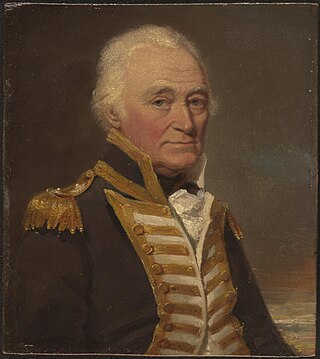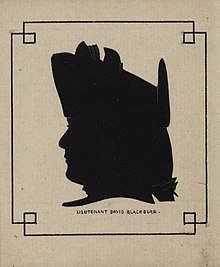
Admiral Arthur Phillip was a British Royal Navy officer who served as the first governor of the Colony of New South Wales.

The First Fleet was a fleet of 11 ships that brought the first European and African settlers to Australia. It was made up of two Royal Navy vessels, three store ships and six convict transports. On 13 May 1787 the fleet under the command of Captain Arthur Phillip, with over 1400 people, left from Portsmouth, England and took a journey of over 24,000 kilometres (15,000 mi) and over 250 days to eventually arrive in Botany Bay, New South Wales, where a penal colony would become the first European settlement in Australia.

HMS Sirius was the flagship of the First Fleet, which set out from Portsmouth, England, in 1787 to establish the first European colony in New South Wales, Australia. In 1790, the ship was wrecked on the reef, south east of Kingston Pier, in Slaughter Bay, Norfolk Island.

Vice Admiral John Hunter was an officer of the Royal Navy, who succeeded Arthur Phillip as the second Governor of New South Wales, serving from 1795 to 1800.
Prince of Wales was a transport ship in the First Fleet, assigned to transport convicts for the European colonisation of Australia. Accounts differ regarding her origins; she may have been built and launched in 1779 at Sidmouth, or in 1786 on the River Thames. Her First Fleet voyage commenced in 1787, with 47 female convicts aboard, and she arrived at Botany Bay in January 1788. On a difficult return voyage in 1788–1789 she became separated from her convoy and was found drifting helplessly off Rio de Janeiro with her crew incapacitated by scurvy.

Scarborough was a double-decked, three-masted, ship-rigged, copper-sheathed, barque that participated in the First Fleet, assigned to transport convicts for the European colonisation of Australia in 1788. Also, the British East India company (EIC) chartered Scarborough to take a cargo of tea back to Britain after her two voyages transporting convicts. She spent much of her career as a West Indiaman, trading between London and the West Indies, but did perform a third voyage in 1801–02 to Bengal for the EIC. In January 1805 she repelled a French privateer of superior force in a single-ship action, before foundering in April.

Lady Penrhyn was built on the River Thames in 1786 as a slave ship.
Alexander was a merchant ship launched at Hull in 1783 or 1784. She was one of the vessels in the First Fleet, that the British government hired to transport convicts for the European colonisation of Australia in 1788. On her return voyage from Australia the British East India Company permitted her to carry a cargo from Canton back to Britain. Thereafter she traded out of London until 1809, when she is no longer listed.
The following lists events that happened during 1788 in Australia.
George Raper was a Royal Navy officer who as an able seaman joined the crew of HMS Sirius and the First Fleet to establish a colony at Botany Bay, New South Wales, now Australia. He is best known today for his watercolour sketches of the voyage and settlement, particularly birds and flowers of Sydney Cove.

Henry Lidgbird Ball was a Rear-Admiral in the Royal Navy of the British Empire. While Ball was best known as the commander of the First Fleet's HMS Supply, he was also notable for the exploration and the establishment of colonies around what is now Australia and New Zealand. Specifically, Ball explored the area around Port Jackson and Broken Bay, helped establish the Norfolk Island penal settlement, and discovered and named Lord Howe Island.
William Bradley was a British naval officer and cartographer who was one of the officers who participated in the First Fleet to Australia. During this expedition, Bradley undertook extensive surveys and became one of the first of the settlers to establish relations with the aborigines, with whom he struck up a dialogue and whose customs and nature he studied extensively. He later however fell out with his aboriginal contacts and instead undertook a mission to gather food which ended with an eleven-month stay on Norfolk Island after a shipwreck.
Captain Henry Waterhouse was an English naval officer of the Royal Navy who became an early settler in the Colony of New South Wales, Australia. He imported to Australia the continent's first Spanish merino sheep, whose wool became one of the colony's best exports.

Commander John Shortland (1739–1803), was a Royal Navy officer, known for being the agent for transports of First Fleet, and for exploring and charting islands in the South Pacific.
Peter Kenney Hibbs was an English mariner and a member of the First Fleet to Australia in 1788.

There are 20 known contemporary accounts of the First Fleet made by people sailing in the fleet, including journals and letters. The eleven ships of the fleet, carrying over 1,000 convicts, soldiers and seamen, left England on 13 May 1787 and arrived in Botany Bay between 18 and 20 January 1788 before relocating to Port Jackson to establish the first European settlement in Australia, a penal colony which became Sydney.
Lieutenant Daniel Southwell was an officer of the Royal Navy, who as a midshipman was part of the crew of HMS Sirius when it sailed with the First Fleet to found a penal colony in Botany Bay. He kept a journal and corresponded with his mother, Jane Southwell, and uncle, the Reverend Weeden Butler. This correspondence is held in the British Museum with copies held in Mitchell Library, New South Wales.

The First Fleet Reenactment Voyage was a project to assemble a fleet of tall ships to sail from England to Australia in a historical reenactment of the First Fleet that colonised Australia in 1788. The reenactment was first conceived in 1977 and organised to commemorate Australia's bicentenary of colonisation. Despite opposition and minimal funding from the Australian government, the project attracted the support of high-profile adventurers Thor Heyerdahl, Alan Villiers, and Sir Edmund Hillary, as well as former Australian political figures and the British Royal Family. Several corporations offered to sponsor the fleet as a whole or individual ships, and additional money was raised by selling "training crew" berths for the various legs of the voyage.

David Blackburn was a Royal Navy officer. He was the Master of HMS Supply in the First Fleet that established the British settlement in New South Wales, Australia in 1788.
James Scott was a Sergeant of Marines in the New South Wales Marine Corps and commander of the first quarter guard in New South Wales. He is notable for his journal describing his experiences in the First Fleet, which established the first European settlement in Australia in 1788.













